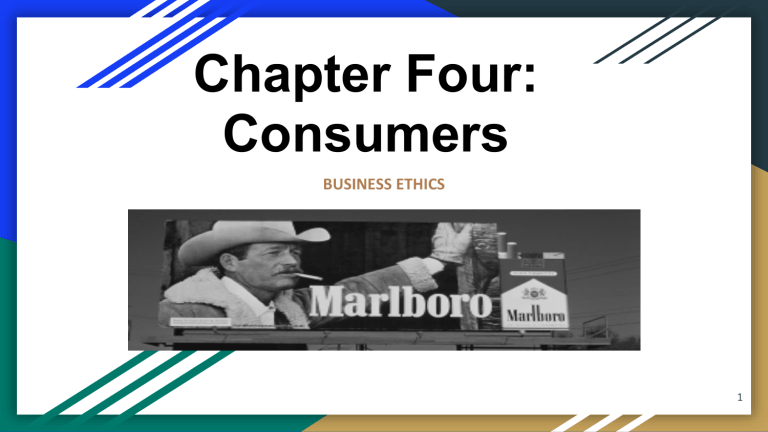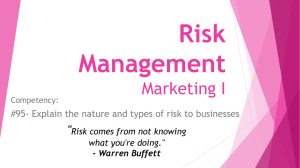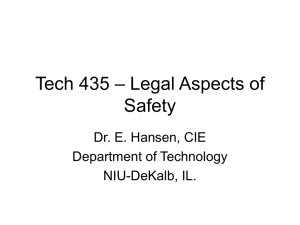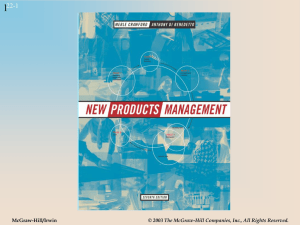
Chapter Four: Consumers BUSINESS ETHICS 1 Overview (1) (2) (3) (4) (5) Chapter Six examines the following topics: Product safety, legal liability, and regulation. Responsibilities of business to consumers concerning product quality, prices, labeling, and packaging. Deceptive advertising and the FTC. “Reasonable” vs. “ignorant” consumer standards. The social desirability of advertising, free speech, and consumer needs. 2 Introduction ❖ With the sale of goods to the public comes responsibility on the part of the manufacturer and advertiser. ❖ Government has some responsibility to protect the public from hazardous or mislabeled goods. ❖ What responsibilities do companies have toward their consumers? ❖ How can goods be promoted while respecting the choices of individuals? 3 Product Safety ❖ Business’s general responsibility for product safety: The complexity of an advanced economy and the necessary dependence of consumers on business to satisfy their many wants increase business’s responsibility for product safety. 4 Product Safety ❖ The legal liability of manufacturers: The 1916 MacPherson vs. Buick Motor Car case expanded the liability of manufacturers for injuries caused by defective products. ❖ Prior to that case, consumers could recover damages only from the retailer of the defective product. ❖ The MacPherson case replaced the older caveat emptor (“let the buyer beware”) doctrine of consumer-seller relationship with a due care one 5 Product Safety Strict product liability: The MacPherson case still left the injured consumer with the burden of proving that the manufacturer had been negligent. Negligence is difficult to prove. A product might be unsafe despite the manufacturer’s having tried to exercise caution 6 Product Safety Strict product liability: In the 1960s, legal thinking became dominated by the doctrine of strict product liability, based on: Henningsen vs. Bloomfield Motors (1960). Greenman vs. Yuba Power Products (1963). This holds the manufacturer responsible for injuries suffered as a result of defects in the product, regardless of whether the manufacturer was negligent. 7 Product Safety Government safety regulation: In 1972, Congress passed the Consumer Product Safety Act. It empowered the Consumer Product Safety Commission (CPSC) to protect the public against “unreasonable risks of injury associated with consumer products.” The CPSC aids consumers in evaluating product safety, develops uniform standards, gathers data, conducts research, and coordinates product safety laws (local, state, federal) and enforcement. 8 Product Safety ❖ Economic costs: Safety regulations benefit consumers but raise the price of products – critics worry that the expense is not always worth it. ❖ Consumer choice: Consumers may dislike some mandated safety technology – but in other cases safety regulations may prevent individuals from choosing to purchase a riskier, though less expensive, product. 9 Product Safety (1) (2) (3) Legal paternalism: The idea that the law may justifiably be used to restrict the freedom of individuals for their own good. Some product safety affects not just consumers who purchase products but also third parties. In the increasingly complex consumer world, the assumption that consumers know their own interests better than anyone else is doubtful. Paternalistic regulation may infringe individual autonomy but bring more gain in social welfare 10 Product Safety How effective is regulation? Regulatory agencies (FDA, CPSC) often succeed in protecting interests of consumers and stressing business responsibility. Regulation, however, is not always effective. Public opinion, media attention, pressure from consumer advocacy groups, and the prospect of classaction lawsuits are also effective in forcing companies to take product safety seriously. 11 Product Safety Self-regulation: Businesses generally prefer self-regulation, competition, and voluntary safety standards set by their own industry. But self-regulation can easily subordinate consumer interests to profit making when the two goals clash. Under the guise of self-regulation, businesses can end up ignoring or minimizing their responsibilities to consumers.. 12 Product Safety (1) (2) Automobile safety: The auto industry has a long and consistent history of fighting against safety regulations. Some examples: The industry successfully lobbied the federal government to delay the requirement that cars be equipped with air bags or automatic seat belts. In the late 1990s, the industry denied that car passengers are at a greater risk of serious injury or death caused by collisions with pickups or SUVS than with automobiles. 13 The Responsibilities of Business (1) (2) (3) (4) (5) (6) Protecting the consumer requires more than just obeying the law. It also requires business to: Give safety the priority warranted by the product. Abandon the misconception that accidents result solely from consumer misuse. Monitor closely the manufacturing process itself. Review the safety implications of their marketing and advertising strategies. Provide full details about product performance. Promptly investigate consumer complaints. 14 The Responsibilities of Business Some businesses respond quickly to suspected hazards. Examples of two successful companies: JCPenney and Burning Radios: It withdrew an entire line of defective radios, ran national ads to inform the public, and offered immediate refunds. Johnson Wax and Fluorocarbons: It withdrew all its aerosol fluorocarbon products worldwide after studies showed the released chemicals were depleting the earth’s fragile ozone layer. 15 Other Areas of Business Responsibility (1) (2) Product quality: Warranties are obligations for product quality and reliability that sellers assume. There are two kinds of warranty: Express: The claim that a seller explicitly states. Implicit: The claim, implicit in any sale, that a product is fit for its ordinary, intended use, called the implied warranty of merchantability – it’s not a promise that the product will be perfect but a guarantee that it will be of passable quality 16 Other Areas of Business Responsibility Pricing: For many consumers, higher prices mean better products, so sellers raise prices to give the impression of superior quality or exclusivity – but higher prices do not always mean better quality. Manipulative pricing: Consumers are misled by prices that conceal a product’s true cost – this trickery or manipulation raises moral questions about business’s view of itself and its role in the community 17 Other Areas of Business Responsibility (1) (2) Price fixing: The effort to control a given market and conspire to force consumers to pay artificially high prices. There are two kinds of price fixing: Horizontal: Occurs when competitors agree to adhere to a set price schedule (not to cut prices below a certain minimum, or to restrict price advertising or the terms of sales or discounts). Vertical: Takes place when manufactures and retailers, as opposed to direct competitors, agree to set prices. 18 Other Areas of Business Responsibility (1) Price gouging: A seller’s exploitation of a short-term situation by raising prices when buyers have few purchase options for a much-needed product. Thought generally viewed as unethical, there is disagreement about what it is and whether all instances of it are wrong. The question “What is a fair price?” is not an easy one to answer – one must consider the costs of material and production, operating and marketing expenses, profit margin, etc. . 19 Other Areas of Business Responsibility Labeling and packaging: Business is responsible to provide accurate, clear, and understandable product information that meets consumer needs. Product labels often fail to do this. Package shape, terms, and quantity surcharges may also mislead shoppers. Moral conduct begins by providing consumers with what they need to know to make informed product choices. . (1) 20 Deception and Unfairness in Advertising Labeling and packaging: Business is responsible to provide accurate, clear, and understandable product information that meets consumer needs. Product labels often fail to do this. Package shape, terms, and quantity surcharges may also mislead shoppers. Moral conduct begins by providing consumers with what they need to know to make informed product choices. . (1) 21




